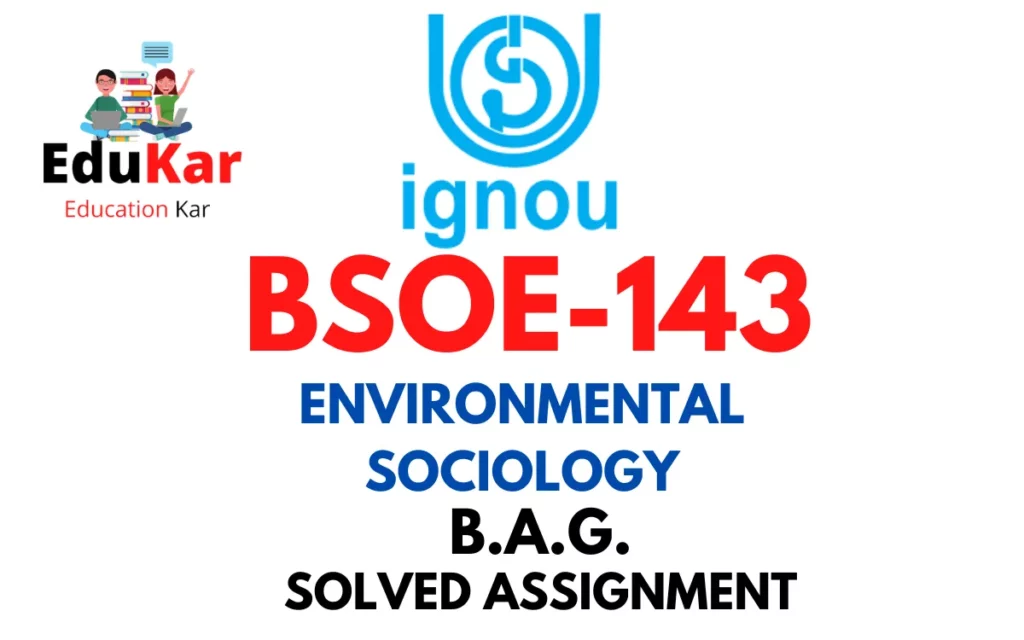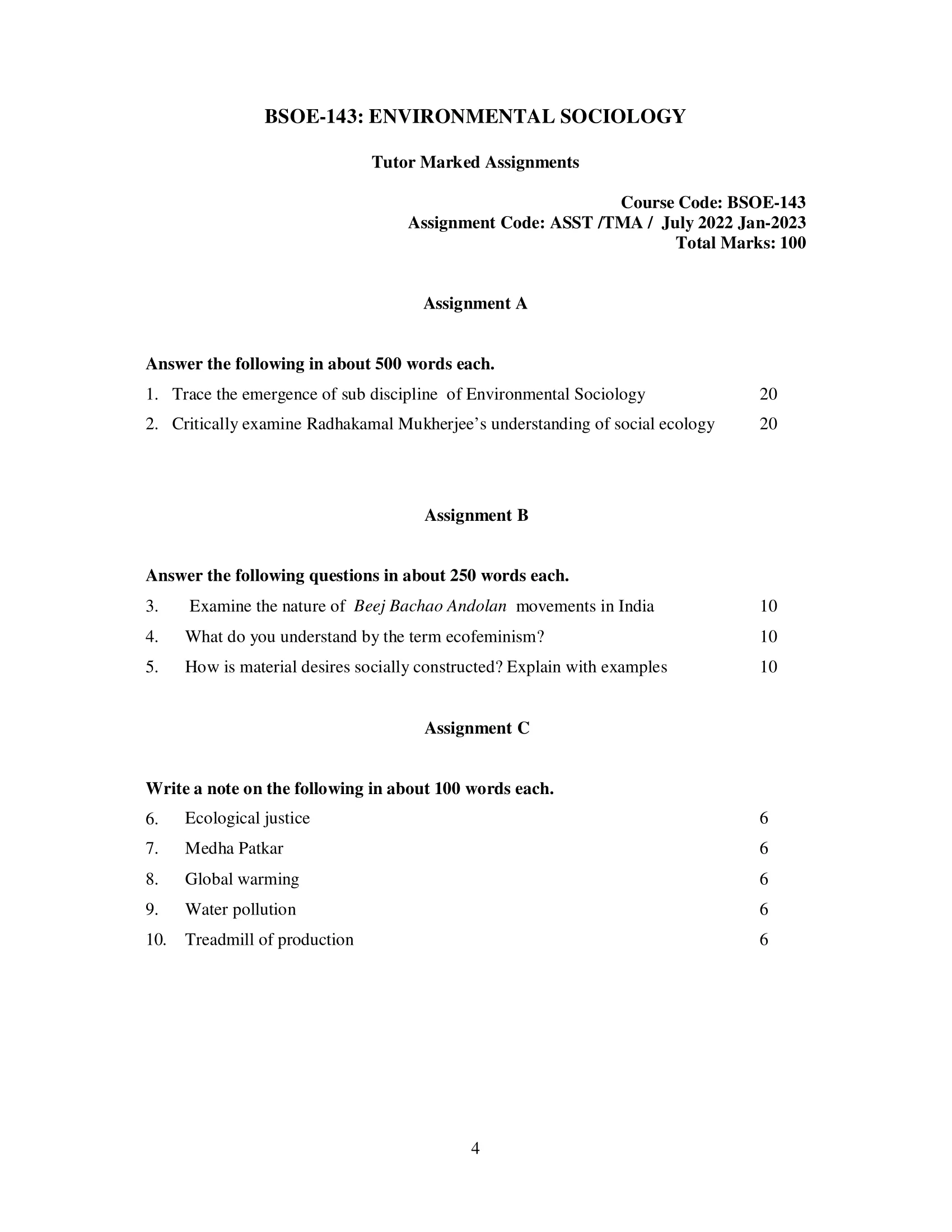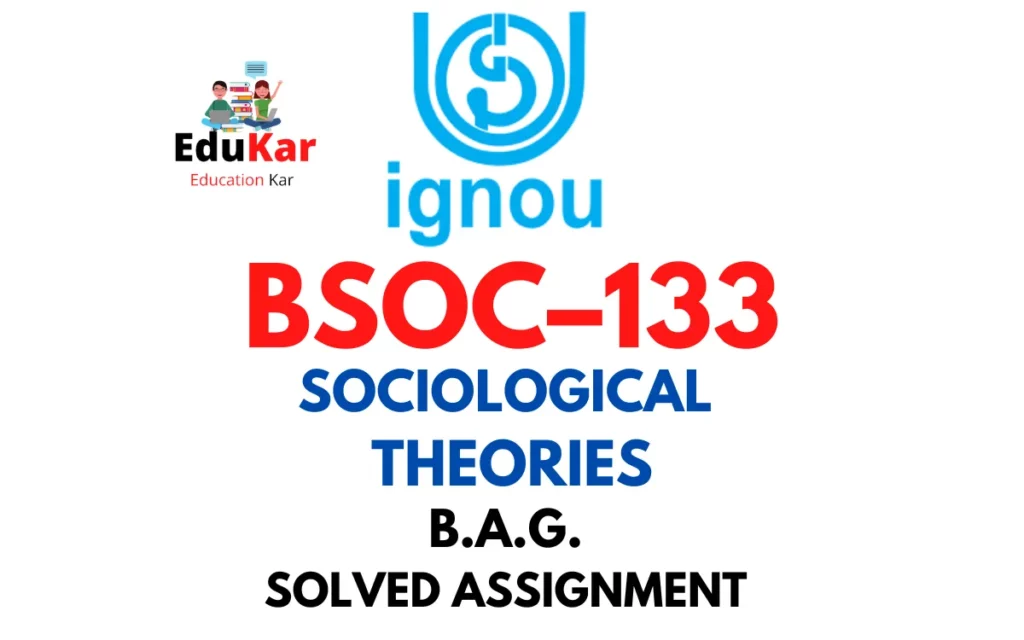Contents
- 1 Assignment A
- 2 Answer the following in about 500 words each.
- 3 1. Trace the emergence of sub discipline of Environmental Sociology.
- 4 2. Critically examine Radhakamal Mukherjee’s understanding of social ecology.
- 5 Assignment B
- 6 Answer the following questions in about 250 words each.
- 7 3. Examine the nature of Beej Bachao Andolan movements in India.
- 8 4. What do you understand by the term ecofeminism?
- 9 5. How is material desires socially constructed? Explain with examples.
- 10 Assignment C
- 11 Write a note on the following in about 100 words each.
- 12 6. Ecological justice
- 13 7. Medha Patkar
- 14 8. Global warming
- 15 9. Water pollution
- 16 10. Treadmill of production

| Title | BSOE-143:IGNOU BAG Solved Assignment 2022-2023 |
| University | IGNOU |
| Degree | Bachelor Degree Programme |
| Course Code | BSOE-143 |
| Course Name | ENVIRONMENTAL SOCIOLOGY |
| Programme Name | Bachelor of Arts (General) |
| Programme Code | BAG |
| Total Marks | 100 |
| Year | 2022-2023 |
| Language | English |
| Assignment Code | ASST /TMA / July 2022 Jan-2023 |
| Assignment PDF | Click Here |
| Last Date for Submission of Assignment: | For June Examination: 31st April For December Examination: 30th September |

Assignment A
Answer the following in about 500 words each.
1. Trace the emergence of sub discipline of Environmental Sociology.
Ans: Environmental sociology is a sub-discipline of sociology that emerged in the mid-twentieth century. The field developed as a response to the growing recognition of the interdependence between human societies and the natural environment. Environmental sociology studies the ways in which social and environmental factors interact and shape one another. It investigates the social processes that create environmental problems and how these problems are solved or managed by individuals, groups, and organizations.
The origins of environmental sociology can be traced back to the 1950s and 1960s, when concerns about environmental degradation began to rise in the United States. Rachel Carson’s book “Silent Spring,” published in 1962, is often cited as a turning point in the development of environmental sociology. The book raised awareness about the environmental and health impacts of pesticide use and led to the creation of the Environmental Protection Agency (EPA) in 1970.
During the 1970s and 1980s, environmental sociology grew rapidly as an academic field. Sociologists such as William R. Catton, Jr., Riley Dunlap, and William Freudenburg conducted research on the social and environmental impacts of economic growth, technological development, and environmental policy. In the 1990s, environmental sociology expanded to include a focus on environmental justice, or the unequal distribution of environmental risks and benefits among different social groups. The field also grew to include research on the social and cultural dimensions of environmental problems, such as the role of cultural values and beliefs in shaping attitudes towards the environment.
Today, environmental sociology is a well-established sub-discipline of sociology. It encompasses a wide range of topics, including climate change, environmental justice, sustainable development, social movements, and the relationship between humans and nature. Environmental sociologists use a variety of research methods, including surveys, interviews, participant observation, and content analysis, to study these topics. They work in academic institutions, government agencies, non-profit organizations, and the private sector.
Ans: Radhakamal Mukherjee was an Indian sociologist and economist who made significant contributions to the field of social ecology. Mukherjee’s work in social ecology drew on his background in economics and sociology, and his understanding of the social and economic structures that shape human society. His understanding of social ecology can be examined critically in terms of his conceptualization of social ecology, its key features, and its limitations.
Mukherjee’s conceptualization of social ecology is grounded in his belief that human societies are shaped by their natural environment, and that social systems are dependent on the natural resources and ecosystems that support them. He argued that social systems are not separate from the natural environment, but are instead intimately connected to it. He also recognized the importance of culture and social structure in shaping the relationship between humans and their environment.
One of the key features of Mukherjee’s understanding of social ecology is his emphasis on the importance of ecological balance. He believed that the natural environment has a self-regulating capacity that maintains ecological balance, and that human societies should work to maintain this balance in their interactions with the natural environment. He also recognized the importance of sustainable use of natural resources and the need for conservation to prevent ecological degradation.
However, Mukherjee’s understanding of social ecology has been criticized for its lack of attention to the social and political factors that shape environmental problems. Critics have argued that his approach overlooks the power dynamics and political structures that contribute to environmental degradation, such as the role of multinational corporations, colonialism, and unequal distribution of resources. Additionally, his approach has been criticized for its emphasis on ecological balance as the primary goal of environmental management, which can be problematic in situations where environmental degradation has already occurred or where ecological balance may not be feasible.
Another limitation of Mukherjee’s approach is its limited attention to issues of social justice and equity. While he recognized the importance of cultural and social factors in shaping human interactions with the environment, he did not fully explore the ways in which social inequality and power relations shape these interactions. This limits his approach in addressing the root causes of environmental degradation and the importance of addressing issues of social justice and equity in environmental management.
Assignment B
Answer the following questions in about 250 words each.
3. Examine the nature of Beej Bachao Andolan movements in India.
Ans: Beej Bachao Andolan is a movement in India that aims to protect and conserve the native seeds of India, which are becoming increasingly endangered due to the growing use of genetically modified seeds and monoculture farming. The movement was initiated by environmental activist and author Vandana Shiva in the late 1980s, and it has since grown into a nationwide campaign with the involvement of farmers, environmentalists, and consumers.
The Beej Bachao Andolan movement aims to promote the use of indigenous seeds in agriculture and to resist the corporate control of seed supply. The movement recognizes the importance of preserving and cultivating native seed varieties, which have evolved over generations to adapt to local climates, soils, and pests. The movement also emphasizes the ecological and social benefits of seed conservation, including the protection of biodiversity, the reduction of dependence on chemical inputs, and the promotion of food sovereignty.
One of the main strategies of the Beej Bachao Andolan is the promotion of community seed banks, which are run by farmers themselves and serve as repositories of local seed varieties. These seed banks enable farmers to exchange and share seeds, as well as to maintain and improve seed quality through traditional breeding methods. The movement also advocates for policy changes at the national level, such as the recognition of farmers’ rights to save, share, and exchange seeds, and the regulation of the use of genetically modified seeds.
Overall, the Beej Bachao Andolan movement represents a grassroots response to the threats of industrial agriculture and globalization, and a call for the protection of India’s rich agricultural heritage. The movement has inspired similar initiatives around the world, and it continues to play an important role in the struggle for food sovereignty and environmental justice in India.
4. What do you understand by the term ecofeminism?
Ans: Ecofeminism is a social and political philosophy that seeks to establish a link between the domination and exploitation of women and the domination and exploitation of nature. The term was first coined in the 1970s by French feminist Françoise d’Eaubonne and has since been developed by a diverse range of scholars, activists, and writers.
Ecofeminism argues that the patriarchal values and social structures that have led to the oppression of women are also responsible for the exploitation and destruction of the environment. The domination of nature and the domination of women are seen as interconnected and mutually reinforcing, and both are rooted in a worldview that values control, domination, and hierarchy.
Ecofeminism encompasses a range of perspectives and approaches, but some of its key themes include the following:
- A critique of the dominant models of development and industrialization, which are seen as ecologically destructive and socially unjust.
- A focus on the importance of nonhuman nature and the recognition of its intrinsic value and rights.
- A critique of the dualistic thinking that separates nature from culture, mind from body, and human from nonhuman.
- A call for a shift in values and ethics toward a more relational, empathetic, and cooperative worldview.
- A recognition of the importance of women’s knowledge, experience, and activism in environmental and social justice movements.
Ecofeminism has been influential in shaping environmental and social justice movements around the world, and it has inspired a wide range of practical initiatives, from eco-villages and community gardens to policy campaigns and international agreements. However, ecofeminism has also faced criticism for its essentialist and homogenizing tendencies, as well as its neglect of the diversity of experiences and perspectives within and beyond the women’s movement.
Ans: Material desires refer to the wants and needs that people have for material goods and possessions, such as clothes, gadgets, cars, homes, and other consumer products. These desires are not innate or fixed, but rather are socially constructed and shaped by cultural, economic, and political factors.
One way in which material desires are socially constructed is through advertising and marketing. Advertisements and media messages create and reinforce consumer desires by depicting products as desirable, necessary, and socially rewarding. For example, a fashion brand might create an ad campaign that portrays their products as the key to social status and attractiveness, leading consumers to believe that they need those products to be accepted and admired by others.
Another way in which material desires are socially constructed is through social norms and expectations. People often have a desire to fit in with their social groups and conform to cultural norms, and this can include the desire to acquire certain material possessions. For example, a person might feel pressure to buy a particular brand of phone or car because it is associated with their social status or identity group, even if they do not necessarily need or value those products in themselves.
Material desires are also socially constructed through economic systems and policies. Capitalism, for example, is based on the idea that consumption and economic growth are key drivers of well-being and progress, and this encourages people to desire and consume more goods and services. Economic policies that promote consumer spending, such as low interest rates and easy credit, can also contribute to the construction of material desires.
Assignment C
Write a note on the following in about 100 words each.
6. Ecological justice
Ans: Ecological justice refers to the fair distribution of environmental risks and benefits, and the recognition that certain communities and groups may be disproportionately affected by environmental degradation and climate change. Ecological justice involves addressing the root causes of environmental problems and working towards a more equitable and sustainable relationship between humans and the natural environment. This can involve advocating for the rights of marginalized communities, supporting environmentally sustainable development, and promoting the conservation and protection of natural resources.
7. Medha Patkar
Ans: Medha Patkar is an Indian social activist who is best known for her work with the Narmada Bachao Andolan (Save Narmada Movement), a grassroots movement aimed at protecting the rights of those affected by the construction of large dams on the Narmada River in India. Patkar is a prominent voice in the struggle for social and environmental justice, and has been involved in a range of social movements throughout her career, including campaigns against forced displacement, environmental degradation, and corporate control of natural resources. She has been recognized for her work with a number of awards, including the Right Livelihood Award (also known as the “Alternative Nobel Prize”) and the Goldman Environmental Prize. Patkar continues to be an influential figure in the Indian social and environmental justice movement.
8. Global warming
Ans: Global warming refers to the long-term trend of increasing average temperatures on Earth, primarily caused by human activities such as the burning of fossil fuels, deforestation, and industrial processes. These activities release greenhouse gases, such as carbon dioxide, methane, and nitrous oxide, into the atmosphere, which trap heat and cause the planet to warm. The consequences of global warming include rising sea levels, more frequent and severe weather events, melting glaciers and sea ice, ocean acidification, and impacts on ecosystems and wildlife. Climate change is a complex and multifaceted issue that requires urgent action to mitigate its impacts and transition to a more sustainable future. This can involve reducing greenhouse gas emissions, transitioning to clean energy sources, protecting and restoring ecosystems, and adapting to the impacts of climate change.
9. Water pollution
Ans: Water pollution refers to the contamination of natural water bodies, such as rivers, lakes, and oceans, by human activities. Water pollution can have a wide range of negative impacts on aquatic ecosystems, human health, and the economy.
There are many different types of water pollution, including:
- Chemical pollution: caused by the discharge of toxic substances, such as pesticides, industrial chemicals, and heavy metals, into water bodies.
- Nutrient pollution: caused by the release of excess nutrients, such as nitrogen and phosphorus, from fertilizers, sewage, and animal waste, leading to harmful algal blooms and oxygen depletion.
- Biological pollution: caused by the introduction of invasive species and pathogens, which can disrupt native ecosystems and pose health risks to humans.
- Physical pollution: caused by the deposition of sediment, trash, and debris in water bodies, leading to habitat destruction and reduced water quality.
Water pollution can have many negative impacts, including:
- Environmental degradation: polluted water can harm aquatic plants and animals, reducing biodiversity and ecosystem health.
- Human health risks: polluted water can pose risks to human health, through drinking contaminated water or exposure to toxic substances.
- Economic losses: water pollution can lead to economic losses in industries such as fishing, tourism, and recreation.
- Infrastructure damage: water pollution can damage infrastructure, such as water treatment plants, pipes, and pumps, leading to higher costs and service disruptions.
Preventing and mitigating water pollution requires a range of strategies, including regulatory policies, technological solutions, and public education and awareness. Effective solutions can include reducing the use of toxic chemicals and nutrients, investing in wastewater treatment and infrastructure, and promoting sustainable agriculture and land-use practices. Overall, addressing water pollution is essential for ensuring the health of ecosystems and human communities around the world.
10. Treadmill of production
Ans: The “treadmill of production” is a concept that describes the dynamic of modern industrial society, in which economic growth and the pursuit of profit drive a never-ending cycle of production and consumption. The concept was developed by sociologist Allan Schnaiberg in the 1980s, and it argues that the pressures of economic competition and resource depletion create a situation where firms must continually expand production and consumption to stay competitive, leading to ever-increasing demands on natural resources and environmental degradation. The treadmill of production has been used to critique the unsustainable nature of capitalist growth, and it highlights the need for alternative economic models that prioritize social and ecological well-being over profit.
How to Download BSOE-143 Solved Assignment?
You can download it from the www.edukar.in, they have a big database for all the IGNOU solved assignments.
Is the BSOE-143 Solved Assignment Free?
Yes this is absolutely free to download the solved assignment from www.edukar.in
What is the last submission date for BSOE-143 Solved Assignment?
For June Examination: 31st April, For December Examination: 30th October















